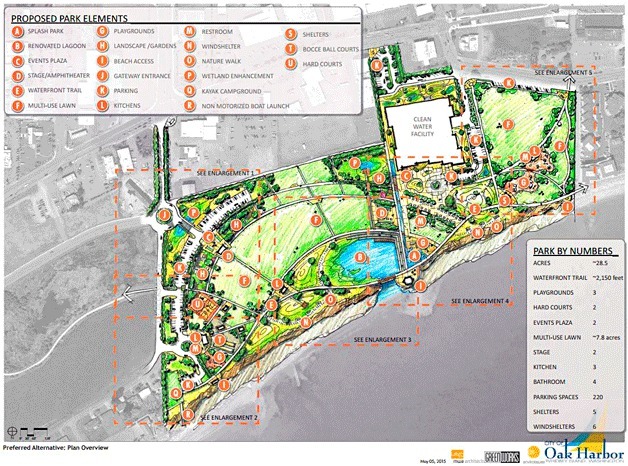Oak Harbor’s waterfront park will likely gain a splash park and lose an RV park as a result of the sewage treatment plant construction.
The building project, which intrudes into the north edge of Windjammer Park, provided the city with an opportunity to create a masterplan for the popular, 28.5-acre park.
Architects and landscape designers worked with city staff members to develop a proposal based on community input.
The result is a “preferred alternative” that Development Services Director Steve Powers and consultants revealed to the City Council at a workshop Wednesday.
The draft will be on the agenda for possible adoption at the June 7 city council meeting.
During an interview with the Whidbey News-Times, Powers said he is pleased with the level of engagement from residents, who participated through an advisory group, open houses and an online survey.
“The community took the time to help us re-imagine Windjammer Park,” he said.
The plan envisions major changes. The RV park and baseball fields are removed from the park. A splash park and a performance space is added. The windmill is moved. The lagoon is reduced in size. Space is earmarked for the possibility of a community room.
But some of the changes won’t happen right away, if ever, since the plan is to phase in much of the project, largely because the city doesn’t have funding to do the entire park at once.
Powers estimates the cost of park improvements at $630,000 an acre, which includes a 30-percent contingency.
The entire park would cost about $18 million.
And just because a couple of elements are taken out of the park doesn’t mean they won’t be built elsewhere.
At the workshop, Gill Williams of GreenWorks explained that the removal of the baseball fields won’t happen until after replacement fields are built elsewhere. City officials have discussed the idea of building state-of-the-art fields, possible at Fort Nugent Park, that can host regional games.
The city’s RV park on Beeksma Drive was closed to be used as a staging area for the sewage treatment plant construction. Officials talked about rebuilding the RV park, but community members told the city that they didn’t want it back in the park.
Councilman Jim Campbell, a proponent of RV parks and an avid RVer, lamented the loss of the park. Powers explained that it could be built at another site, but Campbell said he doubted that would ever happen.
“It’s gone,” he said. “And moving it would not be an option in my mind. The people that use that RV park say the biggest reason they come to that park is its location. If we move it somewhere most of them say they won’t come back.”
Both the consultants and Powers said community members were especially excited about having a splash park, which is a popular alternative to wading pools nowadays.
Under the proposed timeline, the splash park will be one of the first amenities constructed. Powers agreed with Councilwoman Beth Munns that the projects should be done as quickly as possible after the plant is completed in order to capitalize on momentum and community interest.
The plan is divided into phases that can be done over years. Powers said the capital facilities plan calls for phases “1” and “1B” to be completed in 2018, which is immediately after the plant goes online.
Phase 1 consists largely of restoring the landscaping in the areas affected by the sewage plant construction. Phase 1B includes improvements near the water, such as the splash park and play equipment.
Phase 2, set for a couple years out from Phase 1, focuses on improvements to the Beeksma Road area, with a grand entrance that includes the relocated windmill.
Not surprising, the biggest obstacle to implementing the plan will be finding the money. Phase 1 will be funded as part of the sewage treatment plant project.
Phase 1B will likely be funded through a combination of cash from the general fund, park impact fees and possible grants.
Funding for the rest of the phases is to be determined, but Powers pointed to a list of possible grant sources.




